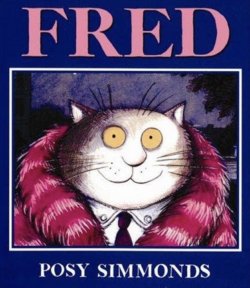Gareth B. Matthews

Review of Fred by Posy Simmonds (London: Penguin, 1989). Originally published in Thinking: The Journal of Philosophy for Children 13(2): 1.
Sophie and Nick were very sad. Their cat, Fred, had just died. As the children pointed out, however, Fred had been quite old. He had, it seems, slept pretty much all the time on laps, on the ironing board, on the washing machine, on top of the fridge, but especially on beds.
Still, everyone in the family was sad that Fred had died. All the neighbors were sad, too.
Sophie and Nick set out with their parents to dig a grave for Fred, out in the yard next to the graves of a guinea pig and a beetle. Nick suggested putting on Fred’s gravestone, “The laziest cat in the world.”
“No, dumbo!” replied Sophie indignantly; “you have to write something nice!” Nick contented himself with writing just the cat’s name, “Fred,” on the grave marker.
That night, the children were awakened by the sounds of the neighborhood cats, who were also mourning the death of Fred. “Did you know him?” one cat asked the children.
“He was ours,” they replied.
“You owned Fred, the most famous cat in the world?” said the cat in disbelief.
“He wasn’t famous,” protested Sophie; “he just slept all the time.”
To the astonished children, the large assembly of mourning cats explained that Fred had been a pop star. Every night he had sung for all the cats in the neighborhood.
In disbelief, the children watched as the neighborhood cats bewailed the loss of their favorite singer and shared, in his honor, a great funeral feast.
Most of us have quite different circles of friends. With one group of associates, I may be fun-loving, with another, I may be studious and shy. People I grew up with may think of me in one way; my college friends, or profession al colleagues, may think of me in another.
A child who goes off to a new school must establish an identity in the new setting. It can be quite frightening to establish oneself with a new crowd. But it can also be liberating.
Interestingly, Fred was known to both his human family and his cat admirers as “Fred.” But people often pick up nicknames in new groups. And sometimes they deliberately alter their names or give themselves a new name.
My younger brother always disliked the name our parents had given him. It had been the name of family friends who had no children themselves. But it was also the name of a make of women’s dresses. When my brother went off to college, he told people he met there that his name was “Buck.” With the new name went a new personality.
Sometimes we worry about having people who know us in one setting meet people who know us in a very different group. When Buck recently took his wife to a high school reunion, there was a clash of expectations. He and his wife found the results amusing. Others might have found them threatening, or traumatic.
Who is Buck, really? And who was Fred? We tend to see ourselves as others see us. But should we? Is it moral of us to play to, now the expectations of this group, and now the very different expectations of that one?
Existentialists have taught us to concern ourselves with such questions of authenticity. But how can I find out who I am, or what I am like, apart from interactions with other human beings? And isn’t it only natural that one group of friends or associates will bring out one aspect of my personality, whereas another will bring out something quite different?
The story of Fred is suitable for children in their very first school years. At this point in their lives, they won’t yet be into Heidegger or Sartre. But they will already have had the experience of establishing themselves in a new social setting. It is good for them to be encouraged to think about what that meant for them, and perhaps about whether they see themselves in a different way in school from the way they see themselves at home, or on the neighborhood playground.
Teachers who encourage the children in their classes to explore these issues should not, however, think themselves exempt from the need for such reflections. It is just as important for a teacher to ask, “Who am I, really?” as it is for children to do so.
Reading the story of Fred is a good way for both teacher and students to start things off.
